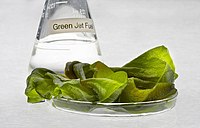
Photo from wikipedia
Abstract In this work, the cerium oxide (CeO2) nanocatalyst was employed as a catalyst to enhance the hydrothermal liquefaction (HTL) of microalgae to bio-oil conversion. The HTL optimized parameters were… Click to show full abstract
Abstract In this work, the cerium oxide (CeO2) nanocatalyst was employed as a catalyst to enhance the hydrothermal liquefaction (HTL) of microalgae to bio-oil conversion. The HTL optimized parameters were obtained from response surface methodology (RSM). The Spirulina Platensis is blue-green algae were used to convert into bio-oil. The major processing method for bio-oil conversion was designed based on three key parameters, such as temperature, residence time and catalyst concentration. A remarkable enhancement of bio-oil production was observed for 0.20 g of CeO2 catalyzed HTL at 250 °C for 30 min, and around 26% of conversion was achieved which is higher than catalyst-free HTL reaction (16%). The synthetic CeO2 nanostructure was characterized using scanning electron microscopy (SEM), field emission scanning electron microscopy (FE-SEM), high-resolution transmission electron microscopy (HR-TEM), brunauer-emmett-teller surface area (BET), X-ray powder diffraction (XRD) and thermal gravimetric analysis (TGA). The chemical composition of bio-oil was analyzed by gas chromatography-mass spectrometry (GC-MS) and the functional group analysis was done using fourier transform-infra red spectroscopy (FT-IR). The obtained results clearly reveal that the major chemical constituents such as hydrocarbons (7.55%), amino acids (36.69%) and nitrogen compounds (21.58%) for the bio-oil increased during CeO2 catalyzed HTL reaction. This investigation depicts that, the CeO2 nanoparticle could be employed as a potential candidate to accelerate the bio-oil conversion through HTL at low temperature from Spirulina platensis.
Journal Title: Energy
Year Published: 2020
Link to full text (if available)
Share on Social Media: Sign Up to like & get
recommendations!